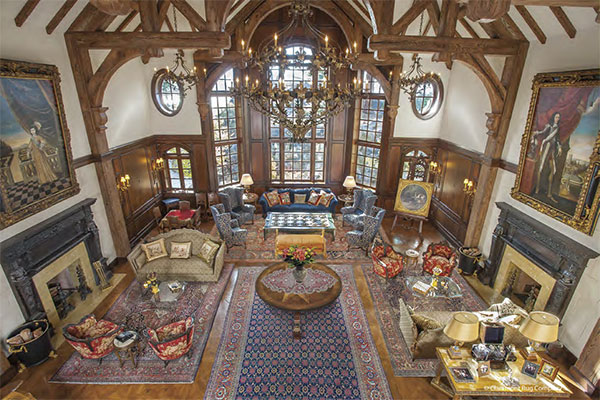Majestic Carpets
Published in Fall/Winter 2020/21 Elliman Real Estate Report
Increasingly collectible, antique Oriental rugs
can transform an interior and transport you to a
bygone era or a far-flung region of the world.

 |
|
An ensemble of compatible antique carpets creates a harmonious look in
this lakeside home in the High Sierras. |
October28, 2020. by Shaun Tolson. - To the uninitiated, the thought of an antique Oriental rug conjures distinct visual characteristics—a specific, albeit limited, interior aesthetic. Contrary to that assumption, decorative rugs woven throughout the Persian Empire during the 19th century and early 20th century offer a vast array of design motifs and color palettes. Jan David Winitz recognized that appeal as a teenager during the early 1970s and subsequently dedicated himself to learning the subject’s nuances. In 1980, at age 25, Winitz founded Claremont Rug Company (800.441.1332, claremontrug.com) and has since spent four decades passionately promoting antique carpets as collectible works of art and stable investments. Winitz has guided hundreds of discerning clients in their quest to accessorize their homes with antique Oriental rugs. The carpets have transformed both urban and rural residences—with classic as well as modern architecture—into stunning living spaces. His clients are drawn to the “eclectic and dramatic unifying impact” they can bring to a home. “Rugs have tremendous appeal on many levels,” Winitz says. “It is remarkable how easily they can fit an environment, a personal design ethos, or the mood their owners wish to create. There is no other art form that provides as much continuous satisfaction.”
KNOW THE BASICS
In basic terms, these antique textiles can be broken down into four categories—tribal, village, town, and city rugs. Most tribal rugs feature geometric patterns (and looser weaves). City carpets are typically tightly woven and defined by sophisticated floral motifs and precise curvilinear designs. Village rugs have angular patterns, while town rugs are more asymmetrical in design and feature novel color palettes. Collectors looking to acquire these pieces as investments should know that no one style is more valuable than another; the finest, earliest, and most artful carpets in the best condition within each group all command top dollar. For small rugs, that could amount to $15,000 to $20,000, according to Winitz. Larger, palatial creations can reach $800,000. According to Louise Broadhurst, the director and international head of Oriental rugs and carpets at Christie’s (+44.20.7839.9060, christies.com), brightly colored tribal rugs from the Kazak region of the Caucasus Mountains can greatly enhance modern apartments. “There’s a huge range of antique carpets that can accommodate modern interiors,” she says. “There are so many new and upcoming [interior] designers who have moved away from that hideous gray period that we went through. It’s not about stark minimalism [anymore]. People are layering and using texture and patterns. They want warmth. They want to experience color and juxtapose designs and be clever.” Winitz has learned that there’s a category of antique Oriental rug that will complement any existing art collection regardless of its focus. “Town and city rugs go wonderfully with impressionist art, and tribal rugs work well with cubism.”
ART UNDERFOOT
Through his Oakland, California, gallery, Winitz specializes in pieces that are 100 to 220 years old—called decorative carpets. Rugs predating that era, which Broadhurst calls “classical carpets,” typically headline the rug and carpet auctions that Christie’s hosts twice a year, but they’re most often bought and sold by institutions and museums that can properly preserve and display them. When it comes to residential settings, antique Oriental rugs are most at home underfoot, though smaller pieces are also hung from walls—a practice that further suggests these carpets are considered fine works of art. Another new trend is to display smaller rugs under glass on dining tables. Many of Winitz’s clients store a portion of their collections in Claremont Rug Company’s climate-controlled vault. He estimates that the vault regularly holds about 700 rugs that rotate in and out of their respective owners’ homes. Some clients have even installed their own rug vaults at home, complete with showroom lighting and built-in bars. Part of an antique carpet’s value stems from the emotional response it evokes. As one longtime Claremont client and art collector from LA says: “A specific rug can change a room, just as a specific piece of art can change a room. When you live with one of these pieces that was designed and woven 200 years ago, it gives something back to you every day.”
|

